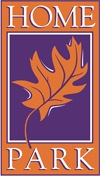




Home Park
History of the Home Park neighborhood
The area of Home Park was originally known as Chastaintown, in honor of Avery Chastain, a large estate owner whose house was at the intersection of Hemphill Avenue and Emmet (now Tenth) Street. Chastaintown was a center for horse trading and until the end of the nineteenth century was a largely undeveloped area of woods and fields with few conveniences associated with city living. In 1901, a group of business associates founded the Atlanta Steel Hoop Company in order to provide a local source of ties and hoops or cotton bales. Atlanta Steel Hoop Company became Atlantic Steel Company in 1907 and went on to become one of Atlanta's largest manufacturing establishments.
The residential development of Home Park was fostered by the growth of Atlantic Steel as well as the Exposition Cotton Mill on Marietta Street and the Miller Union Stockyards off Howell Mill Road. In 1909, the neighborhood was incorporated into the City of Atlanta when a state ordinance expanded the City's boundaries north beyond Fifth Street. Two years later, the Home Park Elementary School opened on the northwest corner of State and Eleventh Streets, occupying property that had been donated for the purpose.
Churches were very much at the heart of Home Park's religious and social life. Residents were predominantly involved with one of the four Methodist churches or the one Baptist church. In 1951 the Methodist churches merged and founded the Tenth Street United Methodist Church at Tenth Street between Tumlin and Hirsch Streets.
The commercial area located at Tenth Street and Hemphill Avenue served as the shopping and social center of the neighborhood. A large brick building at the northwest intersection built by Avery Chastain contained a grocery store, drug store and barbershop among other retail spaces. Accessibility was a major advantage to living in Home Park. The three high schools that serviced Home Park as well as downtown Atlanta were easily accessible by public streetcar. The streetcar line was constructed to service Georgia Tech and Atlantic Steel long before Home Park was incorporated into the City of Atlanta.
Convenience, good schools and churches, abundant grocery stores and other retail shops along with the availability of public transportation made Home Park an attractive neighborhood in which to reside.
In the 1960's, as elderly homeowners died and young homeowners moved to the suburbs. An increasing number of residential properties became available. Georgia Tech was expanding its campus north to Tenth Street, purchasing and converting blocks of neighborhood residential property to institutional use. The increasing student population was difficult to house entirely within the campus borders so many houses were purchased by investors whose sole purpose was renting them to students. The result was subdivided houses, absentee landlords, declining housing conditions and increased crime.
By 1991, the owner-occupancy rate was down to 35%, but change was in the air. Individuals and families desirous of a convenient in-town neighborhood at relatively low cost have at a significant rate been choosing Home Park as their new address. Thanks largely to this renewed interest, our neighborhood has rededicated itself to support of its neighborhood association, the Home Park Community Improvement Association, Inc. Through its actions and organization, the HPCIA has won the respect of the major corporate and institutional giants that are its neighbors to the north, east and south.

The Home Park neighborhood is located about a two-minute drive west of Midtown and bordered on the east side by the Downtown I-75/85 connector. This 100+ year old neighborhood is a dynamic, evolving community of quaint older homes, many built in the 1920’s, 30’s and 40’s, that make up the core neighborhood; and a diverse mix of commercial enterprises and mixed use developments within the Home Park neighborhood, including Atlantic Station within our northern boundary and The Brickworks, M-West, and a myriad of other developments on the west side of the community. Georgia Tech is our immediate neighbor to the south and abuts our southern boundary along 10th Street.
Area: 1,206 sq. miles

